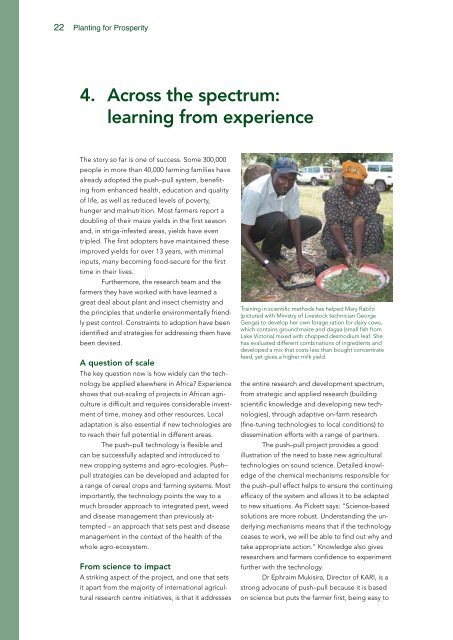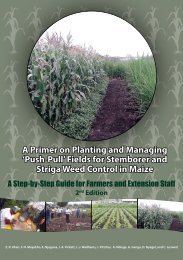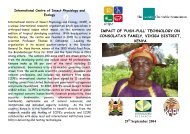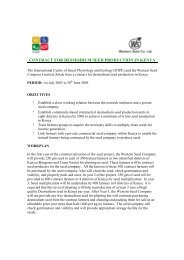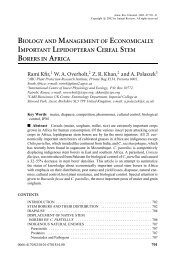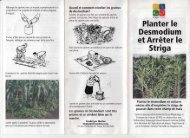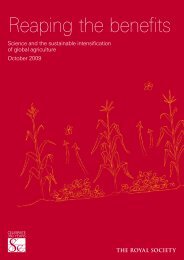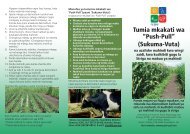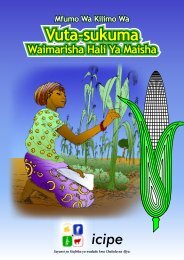a model for Africa's green revolution - Push-Pull
a model for Africa's green revolution - Push-Pull
a model for Africa's green revolution - Push-Pull
Create successful ePaper yourself
Turn your PDF publications into a flip-book with our unique Google optimized e-Paper software.
22 Planting <strong>for</strong> Prosperity<br />
4. Across the spectrum:<br />
learning from experience<br />
The story so far is one of success. Some 300,000<br />
people in more than 40,000 farming families have<br />
already adopted the push–pull system, benefiting<br />
from enhanced health, education and quality<br />
of life, as well as reduced levels of poverty,<br />
hunger and malnutrition. Most farmers report a<br />
doubling of their maize yields in the first season<br />
and, in striga-infested areas, yields have even<br />
tripled. The first adopters have maintained these<br />
improved yields <strong>for</strong> over 13 years, with minimal<br />
inputs, many becoming food-secure <strong>for</strong> the first<br />
time in their lives.<br />
Furthermore, the research team and the<br />
farmers they have worked with have learned a<br />
great deal about plant and insect chemistry and<br />
the principles that underlie environmentally friendly<br />
pest control. Constraints to adoption have been<br />
identified and strategies <strong>for</strong> addressing them have<br />
been devised.<br />
A question of scale<br />
The key question now is how widely can the technology<br />
be applied elsewhere in Africa Experience<br />
shows that out-scaling of projects in African agriculture<br />
is difficult and requires considerable investment<br />
of time, money and other resources. Local<br />
adaptation is also essential if new technologies are<br />
to reach their full potential in different areas.<br />
The push–pull technology is flexible and<br />
can be successfully adapted and introduced to<br />
new cropping systems and agro-ecologies. <strong>Push</strong>–<br />
pull strategies can be developed and adapted <strong>for</strong><br />
a range of cereal crops and farming systems. Most<br />
importantly, the technology points the way to a<br />
much broader approach to integrated pest, weed<br />
and disease management than previously attempted<br />
– an approach that sets pest and disease<br />
management in the context of the health of the<br />
whole agro-ecosystem.<br />
From science to impact<br />
A striking aspect of the project, and one that sets<br />
it apart from the majority of international agricultural<br />
research centre initiatives, is that it addresses<br />
Training in scientific methods has helped Mary Rabilo<br />
(pictured with Ministry of Livestock technician George<br />
Genga) to develop her own <strong>for</strong>age ration <strong>for</strong> dairy cows,<br />
which contains ground maize and dagaa (small fish from<br />
Lake Victoria) mixed with chopped desmodium leaf. She<br />
has evaluated different combinations of ingredients and<br />
developed a mix that costs less than bought concentrate<br />
feed, yet gives a higher milk yield.<br />
the entire research and development spectrum,<br />
from strategic and applied research (building<br />
scientific knowledge and developing new technologies),<br />
through adaptive on-farm research<br />
(fine-tuning technologies to local conditions) to<br />
dissemination ef<strong>for</strong>ts with a range of partners.<br />
The push–pull project provides a good<br />
illustration of the need to base new agricultural<br />
technologies on sound science. Detailed knowledge<br />
of the chemical mechanisms responsible <strong>for</strong><br />
the push–pull effect helps to ensure the continuing<br />
efficacy of the system and allows it to be adapted<br />
to new situations. As Pickett says: “Science-based<br />
solutions are more robust. Understanding the underlying<br />
mechanisms means that if the technology<br />
ceases to work, we will be able to find out why and<br />
take appropriate action.” Knowledge also gives<br />
researchers and farmers confidence to experiment<br />
further with the technology.<br />
Dr Ephraim Mukisira, Director of KARI, is a<br />
strong advocate of push–pull because it is based<br />
on science but puts the farmer first, being easy to


